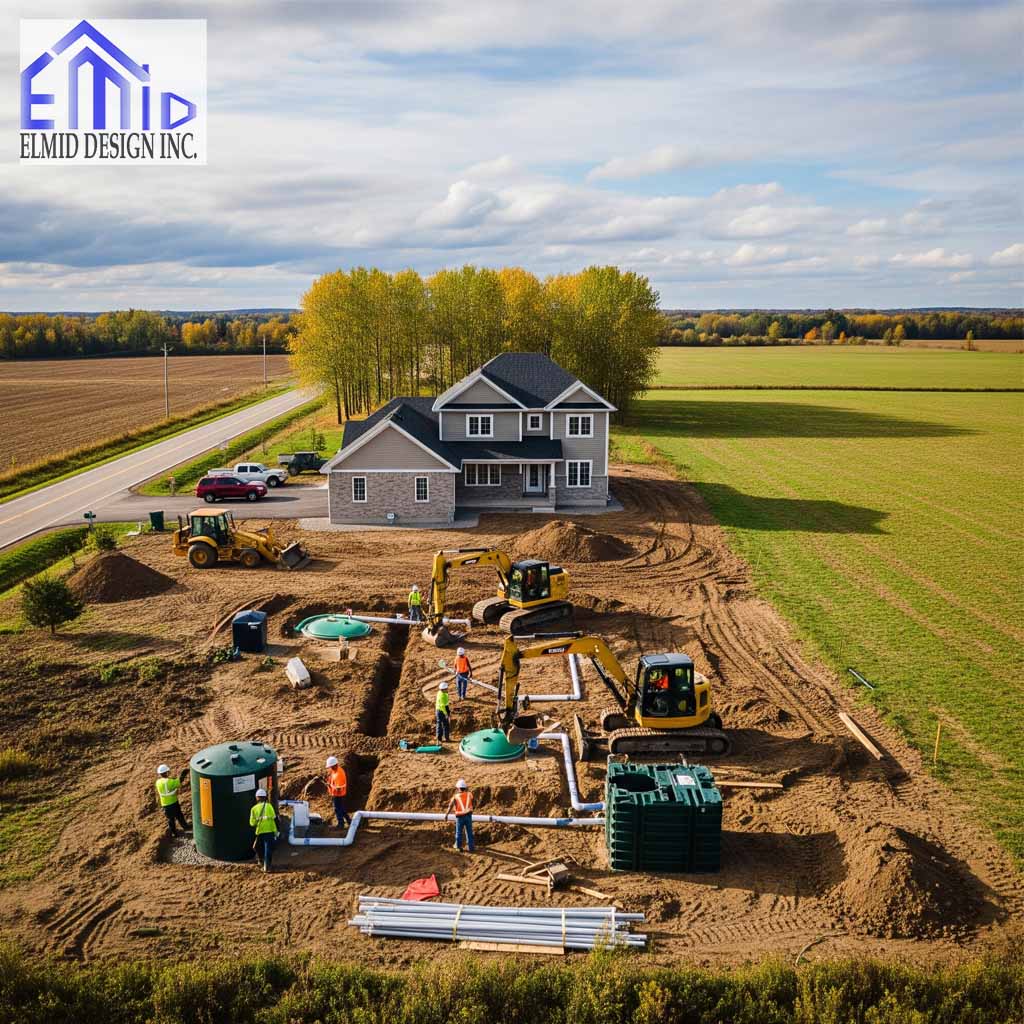Septic design plays a vital role in ensuring the long-term functionality and environmental safety of rural and semi-rural properties in Alliston. With growing development across the Greater Toronto Area and heightened demand for custom home builds and upgrades, many homeowners face the challenge of creating a septic system that meets Ontario Building Code standards while adapting to property-specific soil, elevation, and usage needs. Understanding the essentials of septic design, the local permitting process, and the importance of proper planning can help residents in Alliston protect their investment, avoid costly mistakes, and maintain a healthy, efficient waste water treatment solution for decades to come.
Understanding Septic Design Basics in Alliston
Septic design involves engineering a custom wastewater treatment solution that works efficiently with a property’s natural landscape, household size, and local soil conditions. In Alliston, where suburban development meets rural land, septic systems are often the only viable waste management option. Every design must factor in water table levels, setbacks from wells or bodies of water, and terrain slope. Homeowners must also comply with the Ontario Building Code Part 8, which governs sewage systems under 10,000 litres per day. A professional designer evaluates flow rates, site characteristics, and projected usage to determine the type of system best suited for the property. Whether it’s a conventional trench system or a tertiary treatment unit, careful planning ensures regulatory compliance and long-term reliability.
Site Evaluation and Soil Analysis
One of the most critical steps in the septic design process is conducting a detailed site evaluation. In Alliston, this includes soil percolation testing to measure how quickly the soil absorbs water. Sandy soils tend to drain faster, allowing for more conventional systems, while clay-heavy or compacted soils may require advanced treatment units. The elevation of the property and proximity to water bodies also influence design decisions. Licensed designers assess slope stability and potential for surface runoff to avoid system failure. These early assessments form the foundation of a system that protects groundwater, prevents backup issues, and satisfies local health unit requirements. Without accurate testing, costly revisions or permit delays may follow.
Ontario Building Code Requirements
Compliance with the Ontario Building Code is mandatory for all septic designs in Alliston. The code outlines requirements for system sizing, component placement, and material use based on fixture counts and household occupancy. Systems serving new builds or expansions must also undergo municipal approval through a local inspector, typically under the Simcoe Muskoka District Health Unit’s oversight. The Code also requires specific distances between septic tanks, distribution beds, wells, property lines, and buildings to protect public health and safety. Septic systems must be installed by licensed professionals with full documentation, and deviations from standard practices must include engineered designs. Homeowners should work with experienced designers familiar with regional standards to ensure their systems are approved without delay.
Common Types of Septic Systems in Alliston
Alliston homeowners often rely on one of several system types, depending on property constraints and household needs. Conventional gravity-fed systems use a septic tank and a leaching bed to process and disperse effluent into the soil. These are ideal for well-draining properties with enough land to accommodate trench spacing. In tighter or poorly drained lots, advanced systems such as pressurized distribution or tertiary treatment units may be necessary. These units include filters and pumps to treat wastewater more effectively and fit within limited spaces. Each system comes with different installation costs, maintenance requirements, and longevity expectations. Selecting the right option requires professional guidance, especially in environmentally sensitive zones.
Design Considerations for Custom Homes
Custom home construction in Alliston requires an integrated approach to septic design. Designers must consider how many bathrooms, kitchens, laundry appliances, and other water fixtures the house will have to calculate total daily flow. The septic system must accommodate peak demand without compromising treatment quality. Future expansions or accessory dwellings should also be considered at this stage. For larger homes or those with luxury features like spas or home salons, higher-efficiency systems may be recommended. Designs must also accommodate driveway placement, landscaping plans, and utilities without interfering with the leaching bed. A collaborative approach between homeowners, builders, and designers ensures the septic system supports both immediate needs and future changes.
Permit Process and Local Approval
In Alliston, septic permits are typically reviewed and issued by the local health unit, which ensures each system complies with public health and safety standards. The permit application must include design drawings, site maps, soil test results, and a completed Schedule 2 form. In many cases, designers handle the submission process on behalf of the homeowner. The review period may vary depending on workload and seasonal demand, but incomplete applications will not be processed. Once approved, the homeowner must schedule inspections during installation to verify code compliance before the system can be used. Choosing a designer with local experience helps streamline approvals and reduces the risk of project delays.
Cost of Septic Design and Installation
The cost of septic design and installation in Alliston can vary widely depending on the type of system, property conditions, and regulatory requirements. Basic designs for conventional systems may start around a few thousand dollars, while complex systems requiring tertiary treatment or engineered solutions can exceed $20,000 in total project cost. Soil type, site grading, and environmental setbacks all influence final pricing. Homeowners should factor in both design fees and construction costs when budgeting for septic projects. While choosing the lowest bid might seem economical, investing in high-quality design services pays off through improved system performance and fewer future repairs. Long-term durability starts with smart planning.
Environmental Impact and Water Table Protection
Improperly designed or poorly maintained septic systems can contaminate the groundwater table and surrounding environment. In Alliston, many properties rely on private wells for drinking water, increasing the need for careful system placement and advanced treatment. Design professionals must avoid high-risk zones and provide safeguards against system overload. Using licensed installers and regular inspections helps prevent soil saturation, effluent runoff, and nutrient pollution in local watercourses. Environmentally responsible septic systems also contribute to the health of local ecosystems, supporting sustainable growth in the region. A well-designed system not only protects homeowner investments but also preserves natural resources for future generations.
Importance of Licensed Septic Designers
Only licensed septic system designers registered with the Ministry of Municipal Affairs and Housing can prepare and submit design documents in Ontario. These professionals bring technical expertise and regulatory knowledge to the project, ensuring compliance with complex code requirements. In Alliston, where variable soil conditions and rural planning constraints exist, local experience is essential. Licensed designers understand regional permitting processes, health unit expectations, and common pitfalls. By hiring a qualified expert, homeowners reduce their risk of rejections, costly redesigns, or system failures. Trusted professionals often collaborate with reputable installers, providing a complete service package from design through inspection. Quality begins with qualified planning.
Maintenance Planning and Long-Term Care
A successful septic design includes not only a proper layout but also a long-term maintenance strategy. Homeowners in Alliston should prepare for regular pump-outs every three to five years, depending on system size and household usage. Advanced systems may require annual filter cleanings or alarm checks. Understanding these needs helps extend the lifespan of the system and avoid emergency repairs. Maintenance access points should be clearly marked and protected from vehicle traffic. Designers can include notes in the system drawings to guide future inspections and maintenance. Consistent care keeps the system functioning at peak efficiency while avoiding contamination or mechanical failure.
Design Mistakes to Avoid
Some of the most common design errors include undersized leaching beds, incorrect soil analysis, and non-compliant setbacks. In Alliston, where topography and water features vary widely, overlooking natural gradients or wetland proximity can result in rejection. Systems that rely on outdated sizing formulas or skip percolation tests often face delays or failures. Unlicensed design work, while initially cheaper, typically leads to costlier revisions once inspections begin. Homeowners should resist shortcuts and ensure that every step, from site evaluation to drawing submission, follows best practices. Mistakes made during the design phase are often irreversible once construction begins, making attention to detail critical.
Future-Proofing Septic Systems
As regulations evolve and household needs change, septic systems must be able to adapt. Forward-thinking designers in Alliston consider potential zoning changes, accessory unit additions, and technological advancements. Including space for future system expansion or designing for modular components allows homeowners to make adjustments without full replacement. Smart system monitoring, which is increasingly adopted in newer installations, allows early detection of overload or inefficiency. With proper foresight, today’s design can serve for decades without compromise. Building with tomorrow in mind ensures that septic systems remain functional, safe, and environmentally compliant in the face of change.
Choosing the Right Design Professional
The success of a septic project in Alliston hinges on hiring the right designer. Homeowners should look for individuals with current licensing, positive client reviews, and a portfolio of completed work within the region. Experience with local health authorities and familiarity with the Simcoe County landscape add significant value. Designers who offer detailed proposals and transparent communication set the tone for a well-managed project. Partnering with someone who understands both the technical and regulatory landscape ensures smoother permitting, faster approvals, and long-term system success. Informed decisions at the design stage lay the groundwork for confidence and security.

Seasonal Factors and Climate Impact
In Alliston’s climate, seasonal changes have a direct effect on septic system performance and longevity. Frost depth, snow accumulation, and spring thaw contribute to fluctuations in soil saturation levels that affect leaching bed functionality. During winter, colder soil temperatures may slow down bacterial activity, reducing treatment efficiency. In spring, elevated groundwater tables from snowmelt can hinder percolation and risk surface breakout if the system lacks proper elevation or drainage. A well-designed system accounts for seasonal conditions through careful elevation planning, component insulation, and strategic system orientation. Without proper foresight, seasonal strain may reduce system life span or cause unexpected repairs.
Role of Hydrogeological Studies in Sensitive Areas
In environmentally sensitive or high-density areas of Alliston, septic permit approvals may require hydrogeological studies. These investigations assess how septic discharge interacts with groundwater and nearby wells. In locations with shallow aquifers or fractured bedrock, traditional systems might pose contamination risks. The study results influence whether the design must include added treatment or larger separation distances. Hydrogeological input helps health units and municipalities evaluate cumulative septic impact on local water quality. Designers who collaborate with environmental consultants can streamline the approval process while protecting public health. Where required, these studies become an essential part of responsible septic design.
Water Conservation Strategies in System Sizing
Modern homes increasingly incorporate high-efficiency fixtures and water-saving appliances. When planning septic systems in Alliston, these conservation strategies play a role in determining daily design flow. Reduced water use leads to smaller tank sizes, reduced leaching bed area, and potentially lower overall project cost. Designers must still follow Ontario Building Code minimums but can incorporate usage data from low-flow toilets, front-load washers, and tankless water heaters. Optimizing system size for actual use—not just maximum occupancy—prevents overdesign and associated expenses. Accurate flow projection ensures efficient treatment without overloading soil capacity or underestimating family needs.
Retrofitting Older Systems in Alliston
Many properties in Alliston include aging septic systems installed decades ago under earlier codes. When upgrading homes or applying for secondary units, these outdated systems often require complete redesign or expansion. Common retrofit challenges include undersized tanks, failing tile beds, or proximity to new structures. Retrofitting must account for limited space, existing landscaping, and nearby property lines. Designers may propose compact treatment units or reconfigured layouts to meet code without full excavation. Infill lots especially demand creative solutions. Upgrading systems proactively rather than waiting for failure avoids health risks and ensures regulatory compliance when applying for renovation permits.
Drainage and Surface Water Management
Effective surface water management directly affects septic system reliability in Alliston. Poor drainage around leaching beds leads to saturation, reducing the soil’s ability to absorb effluent. Designers must assess stormwater flow patterns and implement grading plans to redirect surface runoff away from system components. Properties with heavy clay or limited slope may require French drains or swales to maintain dry conditions year-round. Without these considerations, even well-designed systems can fail prematurely. Integrating drainage strategies into initial design ensures long-term stability and eliminates future issues caused by pooling or erosion. Proper drainage preserves soil function and protects the investment.
Tree Root Intrusion and Vegetation Risks
The placement of trees, shrubs, and other deep-rooted plants poses a threat to septic infrastructure. In Alliston, where large lots often include mature landscaping, designers must evaluate the root growth of nearby vegetation. Tree roots can infiltrate tanks, pipes, and distribution lines, leading to blockages and costly repairs. Preferred design practices avoid placing components near tree clusters or use root barriers to protect vulnerable areas. Selecting shallow-rooted ground cover in leaching zones helps maintain system health. By managing vegetation risks from the outset, homeowners prevent long-term system damage and ensure unobstructed wastewater flow through every component.
Zoning Bylaws and Municipal Considerations
While septic regulations are provincial, Alliston’s local zoning bylaws influence system placement and design. Setbacks from property lines, rights of way, or environmentally protected areas may require adjustments. For example, installing a new system on a narrow lot near a stream might trigger additional conditions or require conservation authority approval. Municipal planning departments also review designs in cases involving lot severance, accessory dwellings, or building additions. Working with a designer familiar with both provincial codes and local bylaws reduces the risk of conflict. Understanding jurisdictional layers helps move applications forward efficiently while staying compliant on all levels.
Emergency Planning and Alarm Systems
Newer septic systems, especially those involving pumps or treatment units, often include alarms or monitoring features. These systems provide early warnings of high effluent levels, pump malfunctions, or electrical failure. In Alliston, where power outages may be frequent during storms, backup systems or battery-operated alerts are recommended. Designing with emergency resilience in mind helps homeowners act quickly before a minor issue escalates. Including accessible alarms and risers makes inspections easier and promotes proactive maintenance. Proper planning ensures that emergency situations can be addressed swiftly without damage to the property or health risks to the occupants.
Protecting Wells and Groundwater Sources
Private wells are common in Alliston, especially outside the urban core. Septic designs must protect these drinking water sources through careful siting and treatment planning. Ontario’s regulations require minimum separation distances between wells and any septic components, but thoughtful design often exceeds these standards. Designers assess groundwater flow direction to avoid contamination risks and use treatment systems that reduce nitrogen and pathogens before effluent disperses. Homes with shallow wells or shared water supplies face higher risk and may need engineered solutions. Safe separation between sewage and drinking water protects household health and maintains local water quality for the broader community.
Impact of Terrain and Elevation
Alliston’s topography varies from flat agricultural land to rolling hills and forested lots. Terrain influences how effluent moves through the soil and where system components should be located. Properties with steep slopes require stepped or terraced designs that prevent effluent migration or erosion. Elevated properties may benefit from gravity flow while low-lying areas demand pumped solutions. Designers must walk the property and assess slope grades, drainage paths, and accessible construction areas. Matching the system to the landform improves reliability and reduces installation complexity. Ignoring topography leads to drainage issues, code violations, or long-term system instability.
Insurance and Property Value Considerations
Proper septic design impacts not just system performance but also property resale value and insurability. In Alliston, buyers increasingly request documentation showing that systems are up to code and recently inspected. A professional design with full permits provides peace of mind and supports smooth transactions. Insurance providers may deny coverage for properties with outdated or noncompliant systems, particularly if claims arise due to flooding or contamination. Working with licensed professionals ensures that the system meets modern safety standards and can be validated during future real estate assessments. Investing in design quality protects both the home and its market value.
Septic Inspections and Re-Sale Compliance
Before selling a property in Alliston, many homeowners schedule a septic inspection as part of the pre-listing process. Health units and real estate agents often recommend this step to identify issues early and avoid buyer hesitation. Designers can provide as-built drawings and records that help inspectors verify proper installation and sizing. A compliant, well-maintained system improves buyer confidence and accelerates closings. Properties lacking documentation may face delays or lower offers, especially if system age is unclear. Ensuring records are available, including the original design, permits, and maintenance logs, prepares sellers for a smoother transition.
Preparing for Future Regulation Changes
Environmental and health policies continue to evolve in Ontario, and septic system regulations are no exception. Alliston homeowners benefit from designs that anticipate future requirements, including stricter treatment standards or digital monitoring mandates. Advanced systems already incorporate these features, reducing future upgrade costs. Designers who stay informed about upcoming code revisions ensure their clients receive forward-compatible solutions. Building flexibility into today’s system supports long-term compliance without added disruption. Awareness of regulatory trends allows property owners to protect investments while contributing to sustainable development goals across Simcoe County and beyond. Thoughtful design remains the best hedge against uncertainty.
Frequently Asked Questions
What is a septic system and why is design important?
A septic system is an on-site wastewater treatment solution used where municipal services are unavailable. Design is critical because it ensures proper treatment, protects groundwater, and meets regulatory requirements. In Alliston, systems must follow Ontario Building Code standards and adapt to soil conditions, lot size, and household usage.
Who regulates septic design in Alliston?
Septic systems in Alliston are regulated by the Ontario Building Code and enforced locally by the Simcoe Muskoka District Health Unit. For properties within conservation authority zones or special planning areas, additional approvals may apply. Only licensed designers and installers can submit plans and perform work legally.
How do I know if my property needs a septic design?
If you’re building a new home, adding an accessory dwelling, or replacing an aging system, a septic design is required. Any construction that increases wastewater flow, such as bathroom additions or business use, also demands a new or modified design to ensure code compliance and system performance.
What types of septic systems are most common in Alliston?
Conventional gravity-fed systems are typical on well-draining lots with sandy soils. Where conditions are less ideal, raised bed, pressurized, or tertiary treatment units are more appropriate. A licensed designer evaluates your site to determine the best fit for safety, efficiency, and regulatory approval.
How long does the septic design and approval process take?
The design and approval timeline varies based on site complexity and municipal review load. Generally, site evaluations and soil testing take one to two weeks, and permit approvals may follow within two to four weeks. Incomplete applications or sensitive areas may delay this process.
Can I install a septic system myself?
No. Ontario law requires septic systems to be designed and installed by licensed professionals. DIY systems pose health and environmental risks and will not pass inspection. Unauthorized installation can result in legal penalties and costly removals.
What is the cost of a septic design and system in Alliston?
Design fees typically start at a few thousand dollars, while full system installation may range from $15,000 to $30,000 depending on site conditions and treatment complexity. Advanced systems and poor-draining soils increase costs. Long-term savings come from proper design and efficient system performance.
How often should a septic system be inspected or pumped?
Most systems should be inspected annually and pumped every three to five years, depending on tank size and household use. Advanced treatment units may require more frequent service. Regular maintenance extends lifespan and prevents costly repairs.
Do I need a new design if I renovate or expand my home?
Yes, if your renovation increases water use or adds bedrooms, a new design or system upgrade may be required. The existing system must be assessed for capacity and condition. Non-compliant systems can delay permit approval and resale opportunities.

Why Choose Elmid Design Inc. for Septic Design in Alliston
Elmid Design Inc. is a trusted engineering firm specializing in professional septic design services across Alliston and the Greater Toronto Area. With extensive knowledge of Ontario Building Code regulations, advanced site evaluation techniques, and local permitting processes, our licensed team delivers efficient, code-compliant solutions tailored to your property. We combine technical expertise with personalized service to ensure every system is environmentally sound, cost-effective, and built to last. Homeowners, builders, and developers rely on Elmid Design Inc. for dependable results and a seamless experience from concept to final inspection.
Geographic Locations That We Service:
Our Licensed Professional Engineers specializing in Engineered Site Grading Plans offer the best-engineered site grading plan, lot grading and erosion plan, and drainage plan to obtain site plan approval and building permits in Ontario, including a wide range of municipalities. Each area boasts unique features and requirements, making our tailored approach essential for success.
Toronto and Surrounding Areas
In the vibrant heart of Ontario, we service Toronto (City of Toronto) and surrounding areas. Additionally, we cover Oshawa (City of Oshawa), Pickering (City of Pickering), and Clarington (Municipality of Clarington). Furthermore, our expertise extends to Ajax (Town of Ajax), Whitby (Town of Whitby), Brock (Township of Brock), Scugog (Township of Scugog), and Uxbridge (Township of Uxbridge).
Halton Region
Moving to the Halton Region, our services encompass Burlington (City of Burlington) and Halton Hills (Town of Halton Hills). Also included are Milton (Town of Milton) and Oakville (Town of Oakville).
Peel Region
In the Peel Region, we provide services in Brampton (City of Brampton), Mississauga (City of Mississauga), and Caledon (Town of Caledon).
York Region
Our services in the York Region cover Vaughan (City of Vaughan), Aurora (Town of Aurora), and East Gwillimbury (Town of East Gwillimbury). We also cater to Georgina (Town of Georgina), Markham (City of Markham), Newmarket (Town of Newmarket), Richmond Hill (City of Richmond Hill), Whitchurch-Stouffville (Town of Whitchurch-Stouffville), King (Township of King), and Bradford-West Gwillimbury (Town of Bradford-West Gwillimbury). Each municipality here offers a distinct setting, requiring our specialized approach.
Other Southern Ontario Cities and Towns
We also serve many other cities and towns in Southern Ontario. These include Hamilton (City of Hamilton), St. Catharines (City of St. Catharines), Niagara on the Lake (Town of Niagara on the Lake), Brant (County of Brant), Cambridge (City of Cambridge), Kitchener (City of Kitchener), Waterloo (City of Waterloo), and Woodstock (City of Woodstock). Furthermore, we operate in Guelph (City of Guelph), Centre Wellington (Township of Centre Wellington), Shelburne (Town of Shelburne), Orangeville (Town of Orangeville), New Tecumseth (Town of New Tecumseth), Essa (Town of Essa), Collingwood (Town of Collingwood), Wasaga Beach (Town of Wasaga Beach), Barrie (City of Barrie), Midland (Town of Midland), Orillia (City of Orillia), Ramara (Town of Ramara), Minden Hills (Town of Minden Hills), North Kawartha (Town of North Kawartha), Kawartha Lakes (City of Kawartha Lakes), Peterborough (City of Peterborough), Selwyn (Town of Selwyn), and Brighton (Municipality of Brighton).




